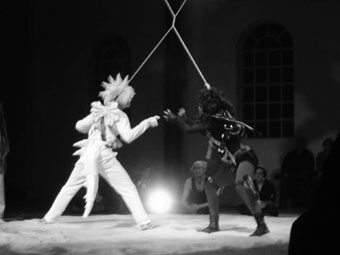Randai moves, eclectic beats
Gillian Arrighi

Ballad of Boldenblee
photo Andrew Brown
Ballad of Boldenblee
Heavy doors swing open and a rhythmic procession enters the cavernous Boiler Shop at Newcastle’s Honeysuckle Rail Yards. The performers are lit by fire poi; balls on strings swung in patterns around the body. Their movements are accompanied by blazing electric guitar. Moving with the percussive sounds of drums, vocalisations, hand clapping and ‘pants slapping’, these exotic others suggest a ritual from somewhere in south east Asia and seem curiously at odds with the icy blast they have brought with them, as though the night wind has blown them in across Newcastle harbour. As they take the performance area—a little circle of sand inside a huge yawning space—2 hooded singers invite us to listen to The Ballad of Boldenblee, director Indija Mahjoeddin’s latest production in her ongoing investigation into the cross-cultural transference of Randai-based performance to Australia.
A popular folk theatre form from West Sumatra, Randai has maintained elements of the martial art Silat as an essential component of its movement repertoire, while evolving into a composite theatre form which embraces storytelling, acting, dance, music and song. The narratives of Randai are in the mythic vein of “hero on an epic quest of good versus bad”, and so it is with Boldenblee, a brave and ambitious Lara Croft-style heroine who sets out to release her brother and town from the clutches of the evil property developer, Munnysuckle. Multiple obstacles line her path, some mental, some spiritual and some physical, such as the elemental figures who engage in an exciting aerial ballet battle for supremacy over the heads of the audience.
The hooded balladeers of the show’s title delivered the bulk of the narrative in songs which shifted across an eclectic range of music idioms, from hip hop beats to rap and blues. It was the live soundtrack of musician Mike Burns (harp and guitars), by turns haunting and strident, which provided a cohesiveness to the storytelling which otherwise became tangled and lacked clarity as it moved to its conclusion.
As with Mahjoeddin’s previous Randai projects, Boldenblee was a community project which drew upon the skills and enthusiasm of its young performers. The outcome was an ensemble work from creation through to performance. The story, the words of the songs and episodic vignettes, and their integration with contemporary verbal styles such as rap, were generated from within the group and helped to shape the piece as much as the physicality of the Randai folk form at its base.
It is the ‘container like’ nature of Randai and its ability to renew and adapt which Mahjoeddin is making use of in her investigation into the cross-fertilisation of this form with contemporary Western music and forms of physical play. References were made to mask, Hapkido and Capoeira. However, I came away feeling that in this production the form had been overloaded, the company undertaking too difficult a task in its allotted preparation time, despite the work’s engaging physicality and visual excitement.
Musik Kabau, The Ballad of Boldenblee, director Indija Mahjoeddin, original songs developed by John Papanis and arranged by Mike Burns; The Boiler Shop at Honeysuckle, Newcastle, Aug 6-14
RealTime issue #63 Oct-Nov 2004 pg. 45






